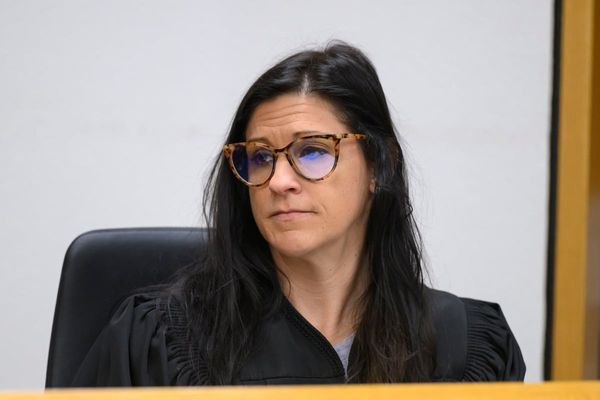Garry Haines was out checking calving cows on November 6 last year in the picturesque Errowanbang valley in New South Wales when suddenly he could not breathe.
Thick, white dust coated the pasture he was riding his bike through.
"The dust was coming up off the grass, from the dust event that happened a few days before," he said.
"And when you're following cattle along they're walking through it, so the dust is coming back up from them."
Mr Haines was forced to abort his rounds of the expectant Murray Grey mothers that morning and attend his local GP immediately.
"It got to the point I couldn't breathe, and I had a really bad cough.
"The doctor took tests on me and wanted to put me straight in hospital.
"I wouldn't go, so I had to sit there on an oxygen mask on for half an hour before she let me come home.
2018 tailing dam wall collapse
Dust events have become common for the people living in the Cadia and Errowanbang valleys since March 2018, when a section of Newcrest Cadia's northern tailings dam wall failed.
Tailings are a by-product of gold mining and are created when rock is pulverised to separate valuable gold from rock.
Chemicals such as diesel and potassium amyl xanthate are added to the ground rock to assist in the separation of gold from ordinary rock particles.
The gold is then removed and the finely crushed rock and chemical slurry dumped in a tailings dam.
Since the dam wall failed, residents of the Cadia and Errowanbang valleys have reported days when the air surrounding them would be thick with dust and their pastures and properties coated.
After a particularly bad dust event, Cadia even supplied crews to the Haineses to assist with the removal of dust from their home.
"It's white dust," Garry's wife Annie explains, who has a chronic cough herself.
What is clean air in NSW?
In Australia, air quality assessment criteria are set by federal legislation called a National Environment Protection Measure (NEPM).
However, in the absence of a federal environmental protection agency, states and territories are not forced to comply with the federal NEPM and not all legislate it themselves.
In New South Wales, industries such as mining self-monitor their air pollution and report any breaches to the Environment Protection Agency (EPA), which controls an industry's licence to pollute.
After repeated dust events were reported by those living in the mine's neighbourhood, Newcrest Cadia personnel installed a solar-powered dust monitor on the neighbouring property to the Haines.
That property is called Errowanbang, owned by John and Hilde Gerathy.
The Gerathys claimed the monitor promptly failed due to dust covering the solar panels.
"I offered [Cadia personnel] full access to mains power," Mr Gerathy said.
Newcrest Cadia's representatives took the broken monitor away.
Dust and morbidity
Tim Driscoll is a professor of epidemiology and occupational medicine at the University of Sydney whose research is occupational exposures, particularly cancers and respiratory complications.
Professor Driscoll has found that exposure to dust typically involves two risk factors — volume and properties.
In August 2019, Newcrest Cadia reported a worker had tested positive to a respiratory disease, but the company said it was unclear if the case was occupational or not.
As a precaution, beards were banned among some workers as they interfered with the effectiveness of mandated dust masks.
Minutes from Newcrest meetings from October 2019, seen by the ABC, showed that then Cadia general manager Peter Sharpe agreed to the community's request for lung health assessments.
The minutes stated Newcrest agreed to replace Mr Gerathy's dust monitor and to test the pastures of properties subject to dust events.
The company conceded to the ABC, that none of these actions were completed.
When asked why these actions were not fulfilled, Cadia's current general manager, Aaron Brannigan, told the ABC that a 2020 Newcrest-led study into the dust concluded community lung health assessments were not necessary.
Results of that study have not been made public.
Professor Driscoll said the only way to evaluate levels of exposure is through measurement.
"To get a realistic understanding, you need to have some measurements of it," he explained.
EPA fines Cadia
On July 31, 2020, Newcrest Cadia was fined $15,000 by the EPA for dust events that had occurred and affected neighbours between March and July last year.
"Even lowish dust levels can cause problems if the particles are small enough to get into the lung system and actually get absorbed into the bloodstream." Professor Driscoll said.
Dust particles are measured as particulate matters (PM). PM10 are larger particles that cannot enter the bloodstream and PM2.5 are small particles that can.
"PM2.5 is thought to increase general levels of inflammation in the bloodstream, " Professor Driscoll said.
Cadia's pollution licence for PM10 is out of step with the EPA's standard, meaning it is allowed to pollute more than guidelines consider safe.
There was no requirement to monitor or report on PM2.5 in Newcrest Cadia's licence.
"Regardless of what type of dust it is, just particles in the air can be damaging to people's lungs," Professor Driscoll said.
GP's advice: 'Get out'
Newcrest Cadia told the ABC that dust suppression was an ongoing investment.
"We've invested more than $24 million to work on dust suppression on our site," general manager Aaron Brannigan said.
"This isn't something that we're done with, we will continue to invest in dust suppression well into the future to minimise the effects of dust on our neighbours."
But despite the mine's assurances, there was an air of resignation about Annie and Garry Haines.
"I feel absolutely powerless and I've given up," Ms Haines said.
Medical advice for them both was drastic and for now, impractical.







